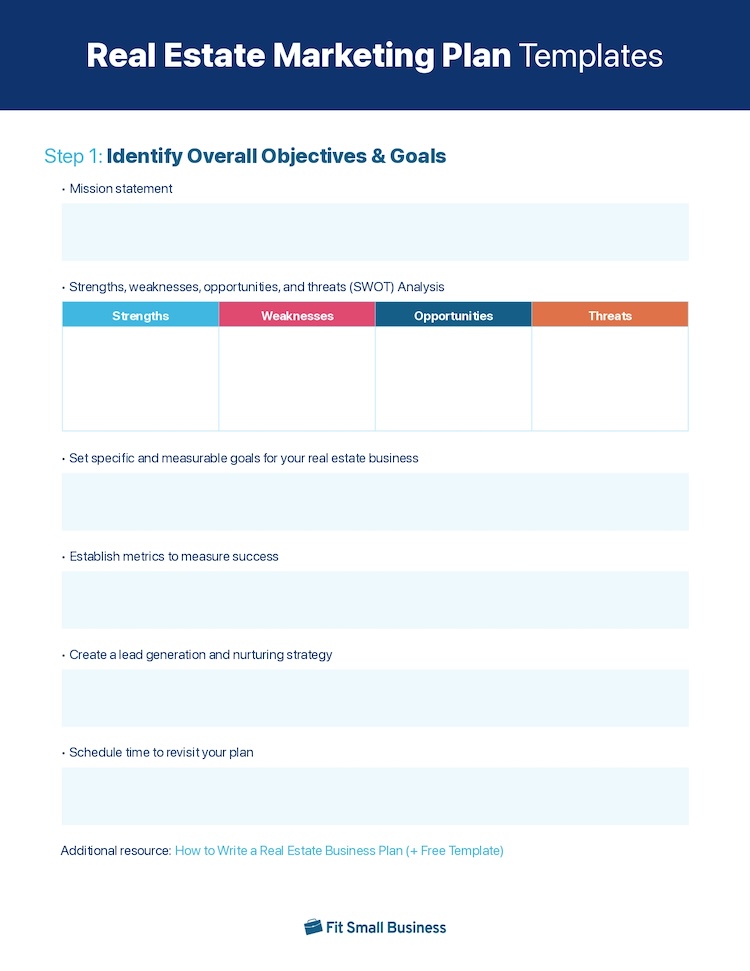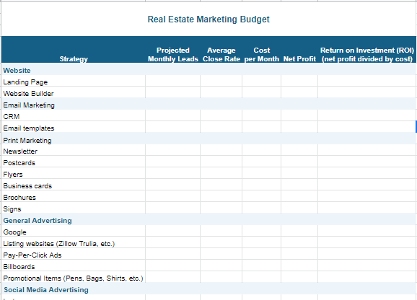If you are determined to be successful as a real estate professional, you need a thorough, informed plan to market yourself efficiently and effectively. Creating a real estate marketing plan should include identifying goals, a budget, your target audience, competition, potential marketing strategies, and your unique selling proposition. With this information, you can implement a plan confidently and see results quickly.
As you read this guide, download the free real estate marketing plan template and use it to outline your own goals and strategies.
1. Create a Business Plan Identifying Overall Objectives & Goals
Creating a marketing plan for real estate starts with a thorough business plan—specifying your unique objectives and goals. A major component of your plans, objectives, and goals is your income goal. According to ZipRecruiter, the national average salary for a first-year real estate agent is about $85,793, but actual amounts range from $28,500 to $149,500, depending on your location, median home prices, and the state of the real estate market.
Other than monetary goals, your business plan should include the following components:
- Mission statement (e.g., Keller Williams Realty Inc.’s mission is to “build careers worth having, businesses worth owning, lives worth living, experiences worth giving, and legacies worth leaving”)
- Strengths, weaknesses, opportunities, and threats (SWOT) analysis
- Specific and measurable goals for your real estate business
- Metrics to measure or prove success
- Marketing strategy and tactics
- Lead generation and nurturing strategy
- Income goal
- Set times to measure progress, revisit, and adjust your plan
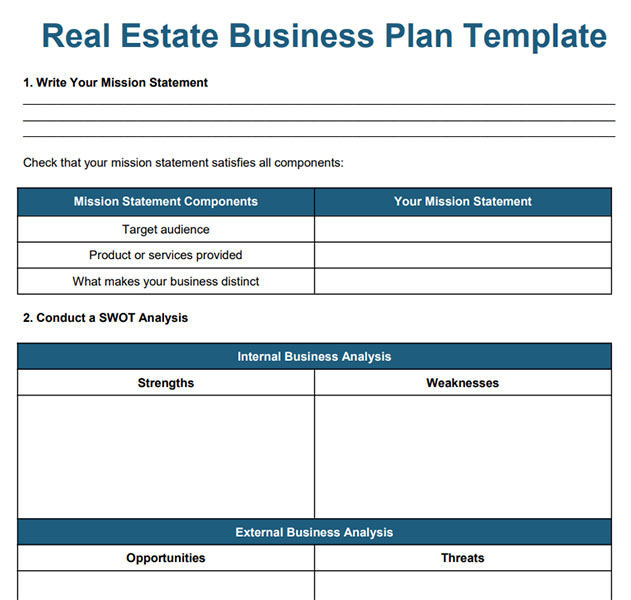
Sample real estate business plan
If you are new to the real estate industry, setting initial goals may seem difficult because you have no past experience or data to refer to. Ask a mentor or colleague for insight about their first year in real estate and their progress in closing deals, marketing, and generating leads. This will give you an idea of how to plan your goals while being realistic to the industry standards for first-year real estate agents.
On the other hand, if you’ve been in the industry for several years, review your previous year’s goals to understand which strategies were successful, which goals you achieved, and the goals to adjust for the upcoming year. By understanding your goals and progress, you can make plans more accurately.
2. Pinpoint Marketing Goals
Now that you’ve laid the groundwork with your business plan, it’s time to identify your general marketing goals for your real estate business. Successful marketing plans for real estate agents use a combination of platforms and strategies to maximize exposure to your business.
It’s important to balance your strategy so that you aren’t spread too thin or dependent on a single real estate marketing strategy. Start by splitting your potential marketing plans into categories, like print materials, online ads, email, and social media, so you can be very specific with your goals and metrics.
Here are some of the real estate marketing mediums to include as you set your marketing goals:
- Real estate website and landing pages
- Email marketing
- SMS and text message marketing
- Real estate ads
- Social media marketing
- Real estate events
- Print marketing materials
- Real estate signs
Consider each potential marketing strategy, as well as recent real estate marketing statistics, to determine which mediums to focus on. Then, create a measurable goal for each one, with each goal statement including how you plan to reach the goal and how you will measure your progress. Take a look at the examples below for inspiration:
Goals | How I’ll Achieve It | How I Will Measure Achievement |
|---|---|---|
Increase market awareness of my personal brand |
|
|
Get more seller clients |
|
|
Capture leads with landing pages |
|
|
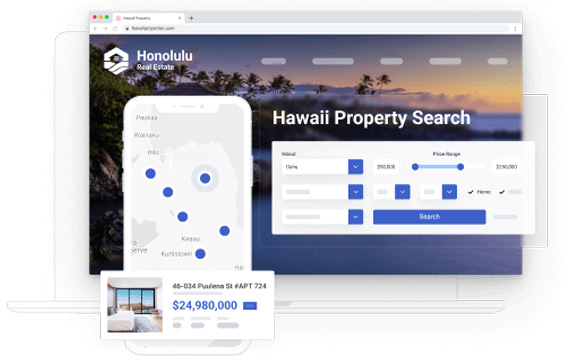
Sample Real Geeks home valuation landing page (Source: Real Geeks)
If you see multiple marketing channels that are likely to be effective, consider using an all-in-one tool like Real Geeks to streamline these tasks. Real Geeks includes a robust customer relationship manager (CRM), an IDX real estate website, lead generation landing pages, email and SMS marketing, automated market reports, and additional integrations. It helps you implement multiple marketing strategies and get a full marketing funnel up and running in hours.
3. Estimate Projected Marketing Budget
To market your business well, you’ll have to spend money. Therefore, creating a real estate marketing plan with a budget is essential for keeping your business profitable. Most agents spend from $0 to $250 per month to acquire leads. New agents who have not completed any deals may not be investing as much in marketing strategies. As you become more experienced and begin to make more money, you can increase your marketing budget accordingly.
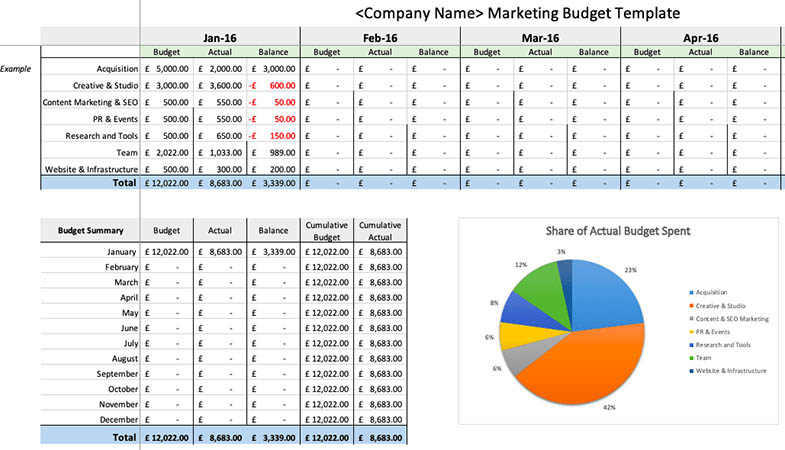
Example marketing budget spreadsheet (Source: Smart Insights)
Your budget should account for all marketing strategies you are employing, including print marketing or online strategies like social media, Google ads, and email marketing. To maximize your budget, evaluate tools for your needs according to their prices, features, and support. Track your spending in the real estate marketing template and this free marketing budget plan template:
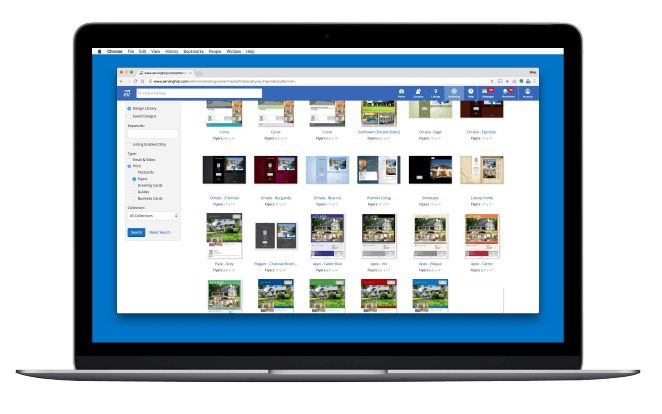
Market Leader provides a content library and a complete marketing suite (Source: Market Leader)
One of your expenses should be a CRM, which will help organize and manage your contacts. Market Leader is one of the leading companies providing real estate lead generation services. It is an ideal choice for agents and teams looking for automated marketing tools to generate and nurture leads. The platform offers several key features, including exclusive leads, customizable IDX websites, and automated digital and print marketing campaigns.
Read what our experts think about this lead generation company and determine if it’s right for your business in our article Market Leader Review: Is It Right for Your Real Estate Business?
4. Know Your Farm Area Data & Identify Target Audience
A real estate farm area is the ZIP code, town, or city where you will focus the majority of your marketing efforts. For your marketing plan to be effective, use geographic and demographic data to guide your marketing strategies and attract your ideal audience.
Free data on your target farm area can be found on websites like Claritas.com and City-Data.com, where you can research specific ZIP codes to understand the area and begin segmenting your audience. Creating segmented groups will increase response rates, differentiate your brand from the competition, attract your target clients, and increase brand loyalty.
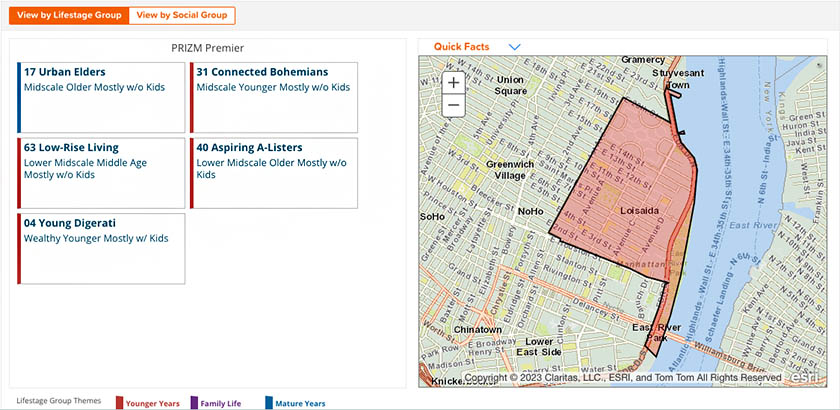
Example of Claritas segmented groups for the East Village, NY (Source: Claritas)
The more data you have about your farm area, the more likely you will attract clients successfully. Before diving into your marketing plan, research and understand other important factors about your location, like home prices, market trends, location demographics, and your ideal client types.
- Home prices and market trends: Knowing the home prices in your farm area is key to speaking confidently to your target audience. Guide buyer and renter clients to the right location based on their purchasing power and assist sellers with listing their homes at appropriate prices so they can quickly sell their homes. Staying informed and updated about local home prices is easy with free tools like Redfin, which has extensive reports that show trends in your area.
- Location demographics: Knowing the demographics of your target area should inform the development of your marketing strategy and real estate branding, including your slogan, logo, and messaging. Having this information will solidify your position as the neighborhood expert.
- Specify target client types: Go deeper by creating personas to fully understand your ideal clients. A persona is a fictional character representing the characteristics of your typical or ideal client. This will make it easy to target a specific audience with real estate marketing materials relevant to their needs and interests. In fact, according to Google’s Marketing and Measurement Survey, 90% of leading marketers see significant business profitability growth after creating personalized customer strategies.
Here are a few example client personas:
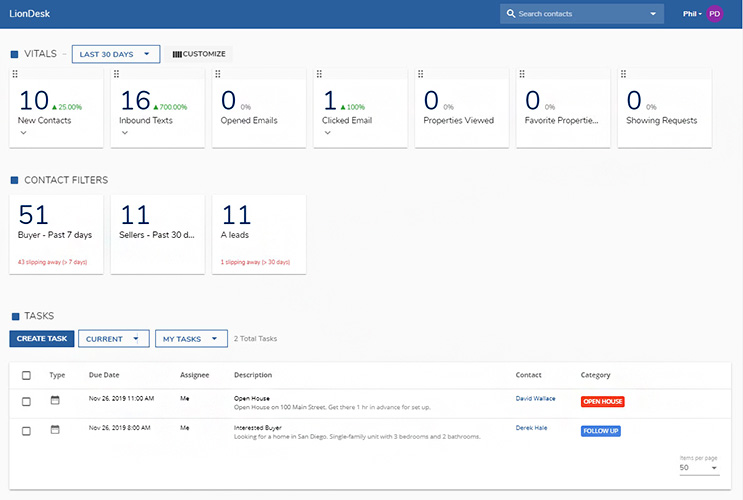
LionDesk dashboard with contact filters (Source: LionDesk)
To keep your client personas organized and segmented, it’s ideal to use a real estate CRM like LionDesk. LionDesk allows you to categorize leads and create different pipelines to customize your marketing for each lead. Plus, it provides multi-channel marketing tools for emails, texts, and direct mail. Try LionDesk free for 14 days.
5. Analyze Market Competition
No matter where you become a real estate agent, you won’t be the only sales agent marketing in your area. Every marketing plan in real estate should be made with an awareness of your competition, which helps you find the most effective and efficient methods to brand yourself uniquely.
Start gathering information about competing agents and brokerages in your area by:
- Driving or biking through your farm area: Take note of signs, branding styles, and marketing materials used by specific brokerages and agents.
- Researching sponsored events: Find local events sponsored by real estate salespeople or companies and consider their audience and professional connections.
- Browsing social media platforms: Look at local real estate agents and brokerages that are active on Facebook, Instagram, TikTok, YouTube, Twitter, and LinkedIn.
- Searching on search engines: Using an incognito browser, search for keywords like “real estate agent East Village” or “houses for sale Milwaukee,” and take note of the agents and website that appear at the top of the page.
- Looking through profiles on real estate platforms: Search for local agents on Zillow, Realtor, or HomeLight, and compare how the top-ranking profiles are written.
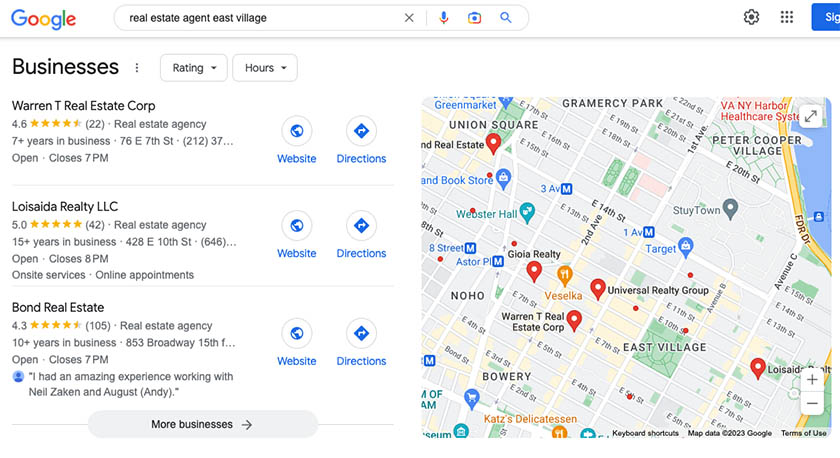
Sample Google search for real estate agents (Source: Google)
Once you’ve collected a range of competing real estate professionals, dig even deeper into each brokerage and agent that offers a similar service. The following are some key factors to consider when evaluating your competition within your real estate marketing plan template:
Brokerage Competition | Individual Agent Competition | |
|---|---|---|
What to Look For |
|
|
The more information you can gather about your competitors’ marketing strategies, the more accurately you can determine which methods to use for your business. You may notice that many agents use direct mail, and very few use online ads. Depending on your audience and competition, this can be a sign that print marketing is more effective with your local audience, or it can expose an opportunity to reach people through online methods with minimal competition.
6. Identify Your Unique Selling Proposition (USP)
With the appropriate research in hand about your audience and competition, you should have a solid understanding of the marketplace and the gaps you can fill. This information is critical for creating your unique selling proposition, which defines what separates you from other real estate professionals in your area.
For example, if you find that very few local agents use virtual tours of listings, including them in your real estate marketing plan can immediately differentiate you from other listing agents. Consider using Matterport to create interactive virtual tours and showcase them on your website or your real estate YouTube channel.
On the other hand, if there’s a gap in the market for a certain home type or target audience, it may be an ideal opportunity for a real estate niche. For instance, if there aren’t any agents who are educated on foreclosure listings, it may be an ideal area for you to invest your efforts and build a reputation as the go-to source for foreclosures.
7. Determine Your Digital Marketing Channels
Almost everyone is on social platforms, making it crucial to utilize digital marketing channels to maximize your reach and build your brand. Consider where your potential customers will see your message to touch base and nurture them effectively. Popular channels for real estate investors include social media, content marketing, and business website.
- Mobile-optimized real estate website: Through your website, prospects can learn more about you, browse listings, and reach out when they’re ready to do business. Optimizing your real estate website for mobile devices can also improve your search engine optimization (SEO) since visitors can access your site on their phones.
- Email marketing: Implementing email marketing can keep prospects engaged through the funnel. It enables passive communication while offering value with each message.
- Social media: In a recent survey by the National Association of Realtors (NAR), social media was the top tech tool for generating quality leads. It is important to have an active and engaging social media presence. This allows you to redirect people to the content you have created on your website, engage with them, and create a dialogue that will help prospects learn more about you as a person, not just your professional work.
- Online ads: Create ads that target specific demographics and interests, and place them on popular websites and social media platforms. Create visually appealing designs and compelling copy to grab the attention of prospects and entice them to click through to your website, profile account, or landing page. Use platforms like Google Ads and Facebook Ads to create and manage your online ads.
8. Establish a Timeline & Set Your Plan in Motion
Now that you have all the components to roll out an effective real estate marketing plan, it’s time to implement your strategies. Even with the best plan, you won’t reach success without staying organized and consistent. That’s why it’s important to create a marketing calendar and follow it to stay on track.
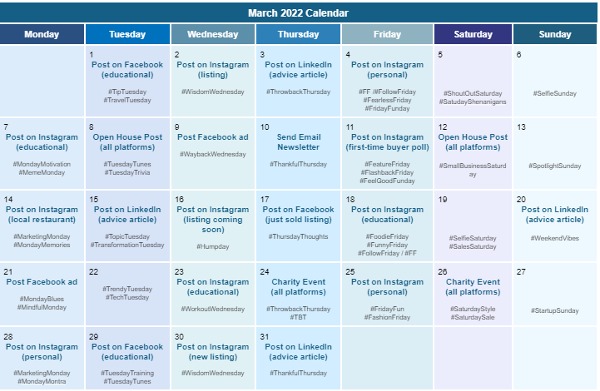
Your calendar should include tasks like social media posts, events, writing email newsletters, sending postcards, and anything else you use to generate and nurture leads. It’s important to make realistic goals, so prioritize the tasks and strategies you believe will most effectively get your name and brand out to the public. Use our free real estate marketing calendar example above that has a bonus hashtag inspiration.
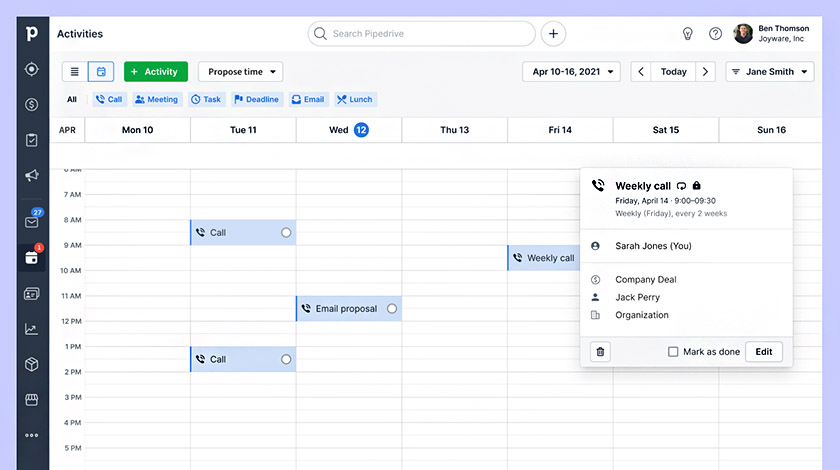
Pipedrive activity calendar (Source: Pipedrive)
Make sure also to consider the availability of a marketing calendar feature as you choose which real estate marketing companies and tools you use. For instance, Pipedrive is a great real estate CRM that includes a calendar with reminders to schedule and manage tasks. This includes an activity tracker for all contacts so you can track interactions with leads and clients across multiple communication channels. Learn more about how Pipedrive can enhance your marketing.
9. Track Your Progress & Readjust as Needed
Your real estate marketing plan is not a set-it-and-forget-it exercise—it should be a living document that continues to be adjusted over time. Reassess your plan at least once a quarter to track progress and adjust as needed. As the year goes by, if you feel that your goals are too lofty or not lofty enough, adapt and rearrange them to fit your small business marketing strategy.
10. Keep Up With the Latest Trends & Adapt
Real estate is a dynamic industry influenced by market fluctuations and emerging trends. Even if you have a set plan, stay flexible and adapt your marketing strategies to align with changing market conditions. Stay on top of the game by regularly monitoring market trends, interest rates, and buyer and seller behaviors.
Embrace technological advancements and innovative marketing approaches. For example, leveraging the latest digital tools or new marketing strategies, such as video marketing, influencer partnerships, and personalized messaging, can differentiate your brand and help you stand out in the crowded marketplace. Being agile in adjusting your tactics ensures that your marketing efforts remain relevant and effective in a rapidly evolving real estate landscape.
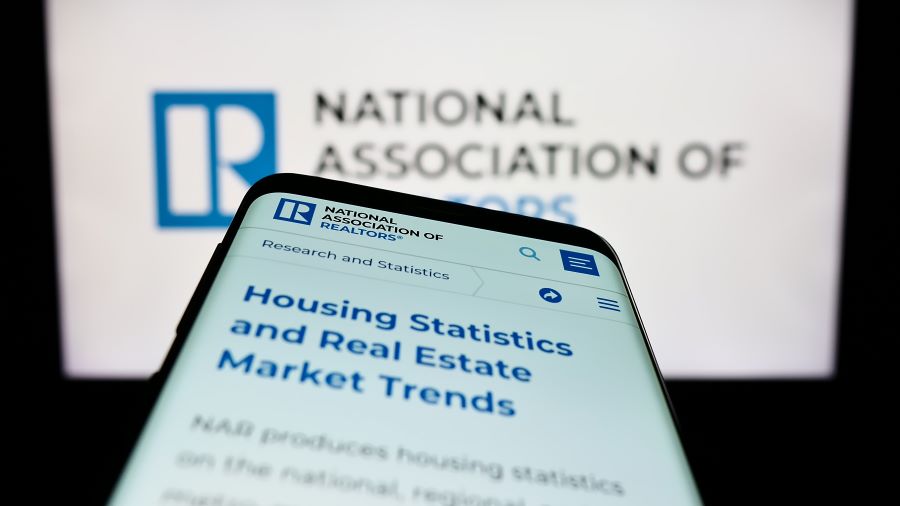
Stay updated on recent developments and market trends (Source: Adobe Stock)
This proactive approach not only positions you as a market-savvy professional but also allows you to seize new opportunities and navigate challenges with resilience. Keep a pulse on the industry, stay informed about the latest marketing tools and platforms, and be ready to pivot your strategies to meet the evolving needs of your target audience.
Frequently Asked Questions (FAQs)
A marketing plan in real estate consists of strategies and tactics that real estate agents and brokers use to promote their properties and services to potential clients. It typically includes the identification of a target audience, competitive analysis, specific goals and objectives, a budget, and a timeline.
The aim is to create a comprehensive and effective plan that helps agents, teams, and brokerages build their brand, attract more clients, and achieve their income goals.
To create a real estate marketing plan, you need to start by identifying your target audience, analyzing your competition, setting specific and measurable goals, establishing a budget, and creating a timeline. Your plan should include a mix of strategies like social media marketing, email campaigns, digital advertising, and leveraging real estate websites. Keep up with industry trends and be ready to pivot your strategies when necessary to ensure your marketing efforts remain relevant and effective.
The best marketing for realtors meets your goals and reaches your target audience. The most effective strategies typically involve utilizing social media platforms, email marketing campaigns, and digital advertisements. Additionally, it could be highly beneficial to leverage the widespread popularity of real estate websites, such as Zillow, which has remained the most popular platform in the industry for several years, to help grow your business more effectively.
Bottom Line
To be successful in real estate, agents, teams, and brokerages need a comprehensive marketing plan. The best plans are built on thorough data, like audience demographics and competition. Your plan must also include specific, measurable goals and strategies to reach your intended audience, build your brand, and, ultimately, achieve your income goals. Download and complete our free real estate marketing plan example and template to get started and grow your business today.
